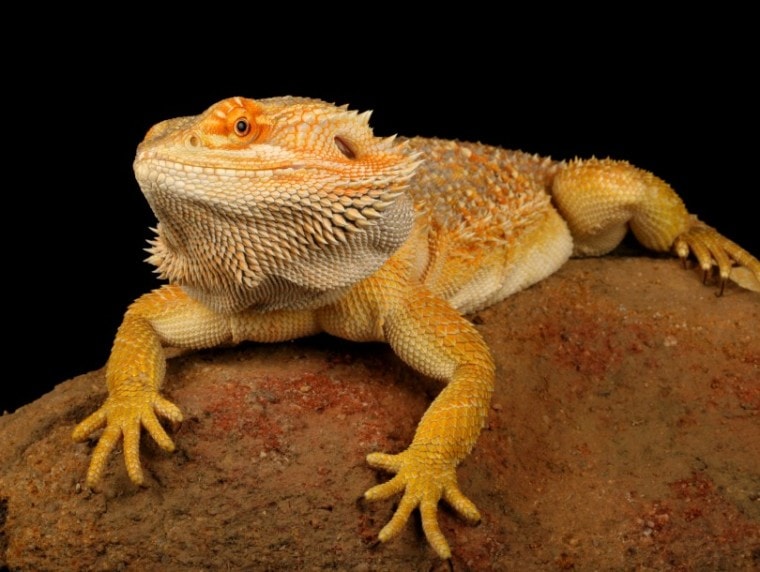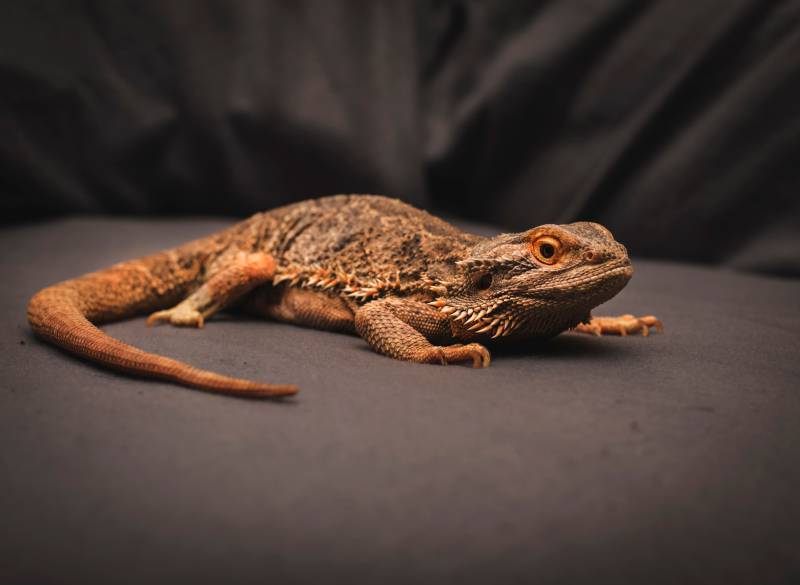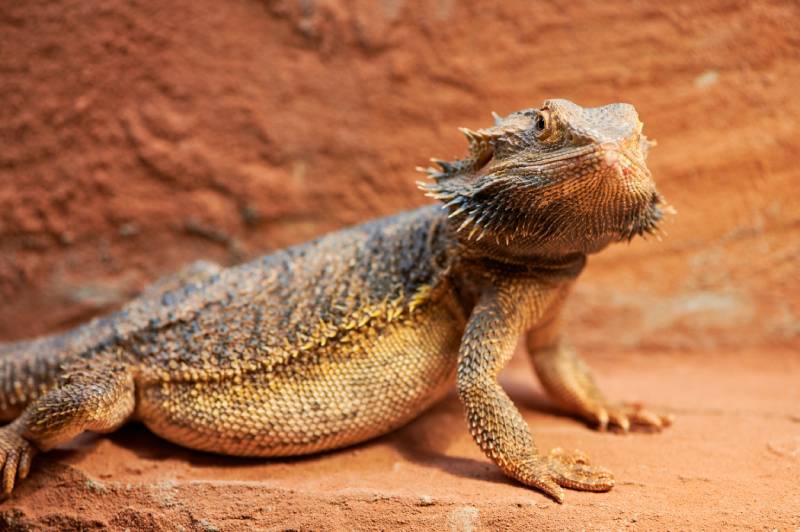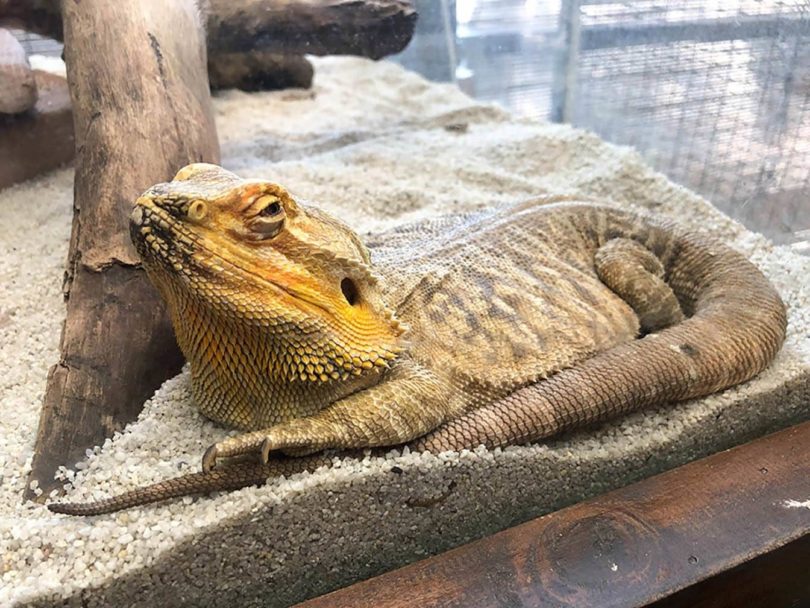
Bearded dragons are excellent household pets and are now found in more than 4 million homes across the United States. They are easy to keep in small houses and apartments, they do not require exercise like some other species of pets, and they can be very well socialized to enjoy spending time with their owners. Though beyond the scope of this article, we cannot emphasize enough the importance of “husbandry” in bearded dragons. This refers to their all-around care: nutrition, hygiene, diet, and environment.
Bearded dragons, like any reptile, are susceptible to developing diseases. The seven most common ones, which will be explored in more detail below, include metabolic bone disease, infectious stomatitis, parasites, yellow fungus disease, respiratory infections, dystocia, and impaction.
The 7 Common Bearded Dragon Health Problems
1. Metabolic Bone Disease
Metabolic bone disease (MBD) causes softening of the bones. It is also referred to as “nutritional secondary hyperparathyroidism”, and is the equivalent of Rickets disease in people. The reason for MBD developing in bearded dragons is relatively complex. It usually occurs due to diets that are high in phosphorus and low in calcium, or low in vitamin D3. However, bearded dragons also require UV-B light to synthesize vitamin D3, so if they do not receive enough of this from a special UV-B lamp, MBD can develop. MBD is more common in juvenile bearded dragons.
Signs of MBD are related to weakness of the bones: swelling under the jaw, swelling of the back legs, difficulty walking, and trembling. Sometimes, bones are so weak that they fracture.
MBD can be diagnosed by a thorough examination, often combined with X-rays and blood tests. X-rays show decreased bone density, fractures, and widening of joint spaces. Blood tests show an imbalance in calcium and phosphorus. Treatment can be attempted and is often successful, but it can be very challenging to repair damaged bones.

2. Infectious Stomatitis
Infectious stomatitis is also known as “mouth rot”. This is a bacterial infection of the gums and jaw that is common in a number of reptile species. Diet and husbandry factors contribute to the development of this disease. Signs of mouth rot include red spots in the mouth and swelling of the gums. After time, bearded dragons develop a thick yellow “cheesy” discharge from the mouth and nose, and show less interest in food due to the discomfort caused by eating.
Fortunately, mouth rot generally carries a good prognosis with appropriate treatment. This comprises a course of antibiotics, and often a special reptile mouthwash, both prescribed by a veterinarian.
3. Parasites
A number of different intestinal parasites can cause disease in bearded dragons. This is a fairly common problem in young reptiles, as well as reptiles recently brought into a new environment. Two common parasites are pinworms and coccidia. In fact, it is thought that pinworms may exist in the gastrointestinal tracts of most bearded dragons; in a healthy lizard with a good diet and hygiene, they exist in such low numbers that they don’t cause any issues. In a sick reptile, or one with poor husbandry, the worms can proliferate to unhealthy numbers, causing illness.
Signs of intestinal parasite infection include loose, malodorous stools and lethargy. Other parasites, such as mites and ticks, are sometimes found on the skin and scales after being transmitted from another bearded dragon. Several oral and injectable anti-parasitic medications can be used in bearded dragons to fix this problem. Mites and ticks may be treated with a topical medication (one that is applied directly onto the skin). As always, husbandry is vital, so cleaning and disinfection of the bearded dragon’s environment is very important.

4. Yellow Fungus
Yellow fungus disease is also known as CANV (Chrysosporium anamorph of Nannizziopsis vreisii). This is a very aggressive and contagious fungus that can affect bearded dragons of any age. Signs of this disease include yellow or yellow-brown raised plaques which can appear all over the body. Without treatment, these plaques become cracked and ulcerated.
This ulceration allows bacteria to enter, causing more infection, and bearded dragons can become very sick. Early treatment is certainly warranted; veterinarians commonly prescribe anti-fungal and anti-bacterial medications.
5. Respiratory Infections
Pneumonia (infection of the lungs) is the most common respiratory infection seen in bearded dragons, though sometimes the infection doesn’t reach the lungs, and is confined to the “upper respiratory tract”. Bacteria, viruses, and fungi are all capable of causing respiratory infections in bearded dragons. Reptiles with poor husbandry are more prone to developing pneumonia. Improper diet, stress, cold environment, and poor hygiene are all contributing factors, as they weaken the immune system.
The most common signs of respiratory illness are sneezing, discharge from the nose and eyes, shallow or labored breathing, or blowing bubbles from the mouth. Severely affected dragons will also be lethargic and anorexic (not eating). Urgent veterinary attention is important—diagnosis may require blood tests and X-rays, and treatment often comprises antibiotics, warmth, feeding, and supportive medications.

6. Dystocia
Dystocia refers to difficulty laying eggs. It is also referred to as “egg-binding” or “follicular stasis.” This is a common and potentially life-threatening problem in female bearded dragons. A number of factors contribute to dystocia: improper diet, poor nesting environment, inadequate UV lighting, and inappropriate temperature control. Underlying infections, abscesses or overly large eggs may make the passage of eggs more difficult.
Again, prompt intervention is required. Veterinarians may use blood tests, X-rays, and ultrasound to confirm the presence of dystocia. Medical treatment can be attempted, but sometimes surgery is necessary to physically remove the eggs.
7. Impaction
Impaction refers to a blockage in the intestines. It can be related to, or exist at the same time as, constipation. Constipation refers to infrequent bowel movements. There are many possible causes of impaction or constipation in bearded dragons, including dehydration, weakness, viral infection, spinal injury, and metabolic bone disease (mentioned above). Some lizards become impacted after eating inappropriate material, often termed “substrate”, from their enclosure. Other lizards develop impactions from urate crystals, which are a product of salts present in their urine. Unlike most mammals, lizards do not have a separate opening for the passage of urine, but instead have a cloaca.
Whatever the cause, bearded dragons with impaction or constipation require rehydration. Occasionally, X-rays will be necessary to diagnose the cause behind the obstruction. Enemas are also a simple and useful treatment if the impaction is in the colon.

Conclusion
Bearded dragons are gaining more and more popularity as household pets across the globe. While often thought of as durable and easy-to-maintain pets, proper care and husbandry are vital to the health of this wonderful reptile. This includes everything from temperature and humidity control to diet and hygiene. It can be difficult to detect signs of illness in bearded dragons, as they are excellent at masking these signs.
If you suspect something is not right, never attempt treatment at home. Early involvement of a veterinarian is likely to lead to the best outcome for you and your bearded dragon.
Featured Image Credit: Audrey Snider-Bell, Shutterstock








